
Gymnastics Skills List: Your Ultimate Guide to understanding the essential floor moves in gymnastics. This comprehensive collection is a treasure trove for anyone keen on understanding or advancing in this dynamic sport.
We’ll dive into the details of each skill, offering insights into their importance and the role they play in a gymnast’s journey.
Let’s get started!
Disclaimer: Gymnastics carries an inherent level of risk. Information contained in this article does not replace the need for professional coaching in a recognized gymnastics facility.
I’m often asked which are the skills that a gymnast should learn first. A Beginner gymnastics skills list will include rolling, jumping and landing, handstands, cartwheels, and this article will look at each skill in detail.
But before learning even the most basic of gymnastics skills, you should be familiar with the common body shapes used in gymnastics such as tuck and pike shapes.
Once a gymnast has mastered these essential skills with good technique, they will be ready to progress onto more advanced gymnastics moves.
Forward Roll
A forward roll is an essential skill to learn for beginner gymnasts as it teaches basic rotation. Rotation is needed in many other advanced skills such as somersaults and handsprings.
By learning a basic forward roll, the gymnast becomes comfortable with going upside down and changing their body shape to help speed up rotation. The most common shape to use in a forward roll is a tucked shape.
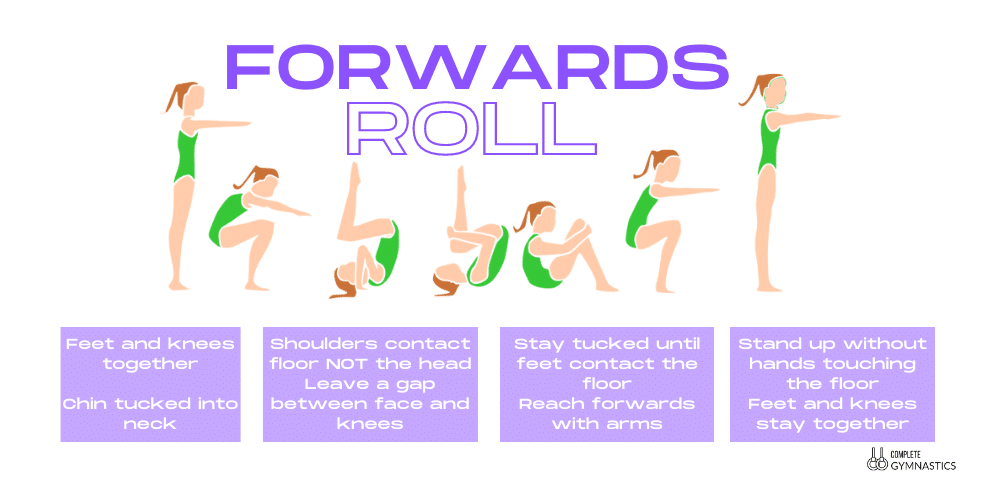
Backward Roll
The backward roll can be trickier to learn for beginner gymnasts as the head often touches the floor. It can be uncomfortable at first but as the gymnast learns to use their hands, it takes the weight off of the head and shoulders and makes the roll smoother.
Backward rolls are a great help to prevent injury. Advanced gymnasts performing backward skills such as back handsprings and back somersaults use the backward roll to recover from a loss of balance. This is especially important when the skills are being performed with a lot of speed and power and it is just too hard to stop still on a landing.
There are many variations of the backward roll which use different body shapes.
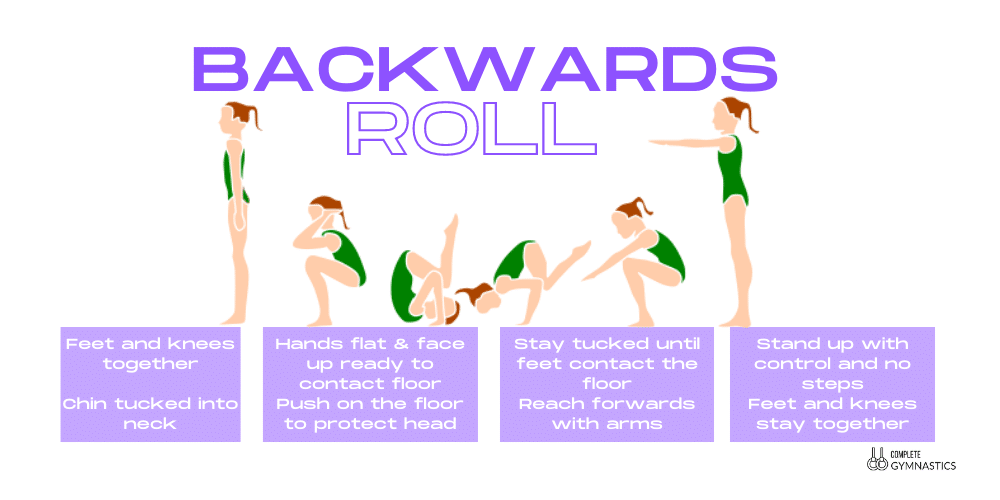
Handstand
Why is a handstand such an important skill in gymnastics? Well, like many other beginner gymnastics skills, it is an important building block for more advanced skills.
The ability to support your body weight, the body shape and body tension needed to hold a good handstand are repeated throughout the sport.
Handsprings and Round Off are just two examples of advanced skills that use the handstand shape. They don’t stay still in a handstand but the body passes through the shape during the skill. Handstand shapes are used on bars, vault, beam and pretty much every other type of gymnastics apparatus.
If there’s one skill you should focus on mastering, it’s the handstand.

Cartwheel
Cartwheel is a must for many beginner gymnasts. Many will have taught themselves how to cartwheel before they even come into gym class, whereas for others it is a big achievement when they finally master it.
It is a bit of a milestone for beginner gymnasts, probably because you can show it off pretty much anywhere!
Good technique is important and so is neatness such as pointed toes and straight arms. Many self-taught gymnasts have to re-learn the correct hand placement when they start a beginner’s gymnastics class.
Did you know that only one hand at a time is supposed to contact the floor? Many gymnasts don’t and they simply plonk both hands down at the same time which can slow down or even stop the legs from traveling smoothly over the head.
Bridge
The Bridge is the first flexibility-based skill I’ve added to this beginner’s gymnastics skills list.
A common misconception is that back flexibility prevents someone from learning a bridge. Shoulder flexibility is actually more important, and stiff shoulders are often the reason a beginner gymnast finds it difficult to push up from the floor.
There are lots of stretching exercises that can help improve shoulder flexibility and with enough practice, most gymnasts can master a good bridge. Once you have it, the bridge will improve your handstands and all of the skills related to a handstand such as back handspring.
Arabesque (scale)
Balance is a key skill for all gymnasts and by learning an Arabesque a beginner gymnast will improve on great balancing techniques.
To perform an Arabesque the gymnast stands on one leg with the other leg extending backward in the air. If performed correctly, the foot will be higher than the rest of the leg and the back will be slightly arched.
Things to remember when holding the Arabesque:
- Eyes forwards
- Chest raised and arched
- Minimum wobble
- Arms extended out
- Leg stretched and toes pointing
Once a gymnast can hold the balance for 5 seconds they have reached a good level of control.
Log Roll
A log roll is a very simple roll that involves rolling from tummy to back or vice versa. It can also be called a pencil roll or a sausage roll.
But to perform it correctly the gymnast must use two important gymnastics shapes – Dish and Arch.
Dish shape is performed with the back on the floor and Arch shape when the tummy is on the floor. As the gymnast rolls, feet and knees must stay together and feet and hands should not touch the floor. This encourages good body tension.
Tuck Jump
Beginner gymnasts must learn to jump and land safely. I have chosen Tuck jump as an important jump to master because it also works an important shape change – straight to tuck and back to straight.
This sequence of gymnastics shape changes is used a lot in more advanced skills such as somersaults and even on more basic skills such as the Squat Through Vault.
A good tuck jump has the knees come up to the chest which requires a fair bit of power. A common mistake is for gymnasts to drop their chest down towards the knees. Avoid doing this as it will cause you to lose balance.
Half Turn Jump
The other jump on my beginner’s skill list is the half-turn jump (1/2). It is the easiest jump to learn which involves a turn (I guess 1/4 turn is easier but it isn’t used in recognized gymnastics skills).
The gymnast now has to control two movements at the same time – jumping up and turning. A good half-turn jump is performed with the chest up and the eyes forward. It is easy to lose balance if you look for the floor. Master the half-turn and you can keep adding multiples of halves until you have a full turn, one and a half etc.
Hurdle Step
A hurdle step is not a recognized skill as such – a gymnast will never perform it in isolation, but it is used to transition from run to jump.
For example when running and jumping onto the springboard for a vault.
We learn this by hopping on one foot and landing on two feet. Sounds simple right? But you’d be surprised how much coordination is required especially by younger beginners.
Frog Balance
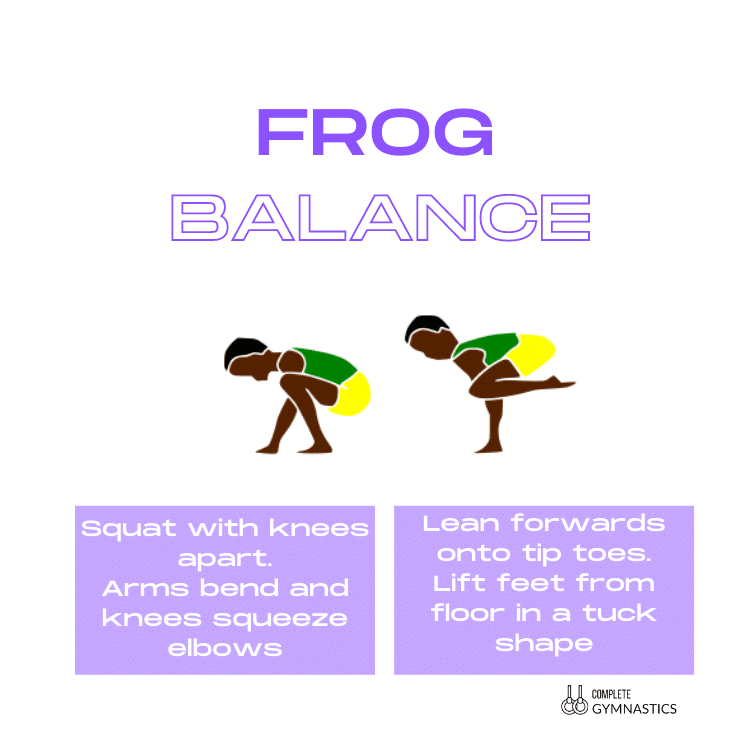
A Frog Balance is a great skill to learn before trying a Headstand.
Crouch down with your knees apart and place your hands in between your feet.
Have your knees press into your arms and lean forward until your on tiptoes.
Your knees should balance on your arms around where your elbows are. For this reason, a Frog Balance can also be called an Elbow Balance.
If you want to develop this into a Headstand you would repeat but with the Head on the floor.
Pike Fold
Pike Fold is an important flexibility move for beginner gymnasts because it stretches the legs (hamstrings, glutes etc) but it also helps stretch the lower back.
A Pike fold is performed by sitting in a Pike and leaning forward so the chest is going towards the legs. Good form is important so a gymnast has to keep their leg straight, knees pressed down and toes pointed.
Gymnastics Skills List In Full
The list below covers all of the major individual skills a gymnast should learn on the floor. These skills are then used to choreograph routines and construct tumbling passes.
Acrobatic Moves
- Aerial Cartwheel
- Back Extension Roll
- Back Handspring
- Back Layout
- Back Layout 1/1 (Full Twist)
- Back Layout 1/2 (Half Twist)
- Back Pike
- Back Tuck
- Back Walkover
- Backward Roll
- Cartwheel
- Forward Roll
- Front Handspring
- Front Layout
- Front Pike
- Front Tuck
- Front Walkover
- Handstand
- Handstand Forward Roll
- Handstand Pirouette
- Round-Off
- Whip Back
Turns, Jumps and Leaps
- Cat Leap
- Double turn (720° turn)
- Full turn illusion turn
- Full turn on one foot
- Full turn with free leg at a 180° split position
- Full turn with free leg in scale above horizontal
- Half turn on one foot
- Hitch Kick
- Pike Jump
- Ring Leap
- Side Leap
- Sissone
- Split Jump
- Split Jump 1/2 turn
- Split Leap
- Straight Jump
- Straight Jump 1/1 turn
- Straddle Jump
- Straddle Jump 1/2 turn
- Switch Leg Leap
- Tour jeté
- Tuck Jump
- Tuck Jump 1/1 turn
- Wolf Jump
- Wolf Jump 1/2 turn
- Wolf Turn
Conclusion
The more time a beginner gymnast spends on understanding this gymnastics skills list, the more chance they have of being successful and progressing onto harder skills. Which skill would you like us to create a tutorial on? Let us know and we’ll do our best to make it happen!
- A Complete Guide to Gymnastics Hand Rips
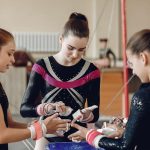 Are you tired of dealing with painful gymnastics rips on your hands from training? Look no further – this article offers a comprehensive approach to… Read more: A Complete Guide to Gymnastics Hand Rips
Are you tired of dealing with painful gymnastics rips on your hands from training? Look no further – this article offers a comprehensive approach to… Read more: A Complete Guide to Gymnastics Hand Rips - Is Gymnastics Dangerous? (Facts and Comparisons)
 Gymnastics is acknowledged as a highly technical and physically demanding sport. It inherently carries a risk of injury, which is why most coaches and clubs… Read more: Is Gymnastics Dangerous? (Facts and Comparisons)
Gymnastics is acknowledged as a highly technical and physically demanding sport. It inherently carries a risk of injury, which is why most coaches and clubs… Read more: Is Gymnastics Dangerous? (Facts and Comparisons) - The Fascinating Evolution of Gymnastics (History and Facts)
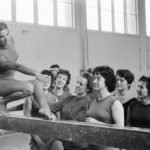 Gymnastics is a sport that has been around for centuries and has evolved significantly throughout history. From its origins in ancient Greece to the modern-day… Read more: The Fascinating Evolution of Gymnastics (History and Facts)
Gymnastics is a sport that has been around for centuries and has evolved significantly throughout history. From its origins in ancient Greece to the modern-day… Read more: The Fascinating Evolution of Gymnastics (History and Facts) - The Ultimate Parallel Bars Skills List
 Parallel bars are one of the most challenging events in men’s gymnastics. Mastering the right moves first on parallel bars is essential to improving your… Read more: The Ultimate Parallel Bars Skills List
Parallel bars are one of the most challenging events in men’s gymnastics. Mastering the right moves first on parallel bars is essential to improving your… Read more: The Ultimate Parallel Bars Skills List - The Long-Term Effects of Gymnastics on the Body (A Complete Guide)
 While gymnastics can offer many benefits, such as improved fitness and self-confidence, many people also ask what are the Long-Term Effects of Gymnastics on the… Read more: The Long-Term Effects of Gymnastics on the Body (A Complete Guide)
While gymnastics can offer many benefits, such as improved fitness and self-confidence, many people also ask what are the Long-Term Effects of Gymnastics on the… Read more: The Long-Term Effects of Gymnastics on the Body (A Complete Guide) - What Age Does Competitive Gymnastics Start?
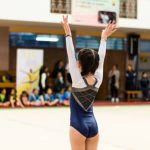 Ever wondered what age does competitive gymnastics start? It’s well known that gymnasts start training at a young age to develop the skills and strength… Read more: What Age Does Competitive Gymnastics Start?
Ever wondered what age does competitive gymnastics start? It’s well known that gymnasts start training at a young age to develop the skills and strength… Read more: What Age Does Competitive Gymnastics Start?
